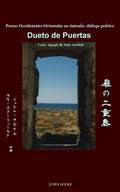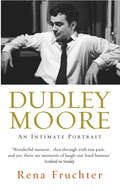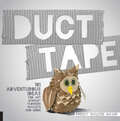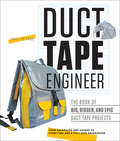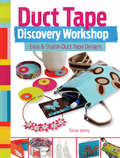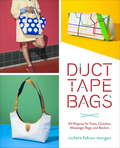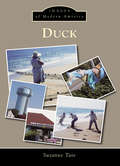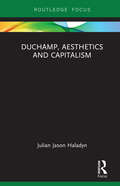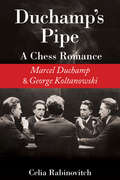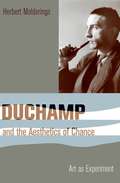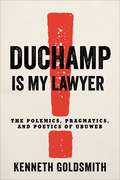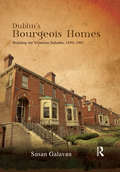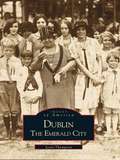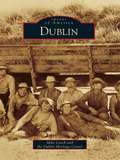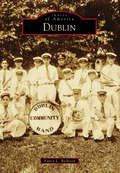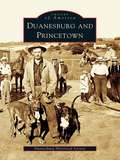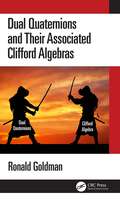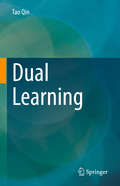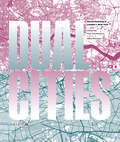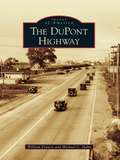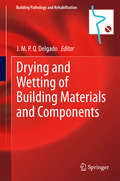- Table View
- List View
Duetto di Porte: Poeti dell’Occidente e dell’Oriente a confronto: un dialogo poetico
by maki starfield/Yesim AgaogleLa poetessa turca Yesim Agaogle e la poetessa giapponese Maki Starfield presentano un bellissimo dialogo in “Duetto di porte”. Le illustrazioni e le foto sono di Yesim Agaogle e Bill Wolak.
Dueto de Puertas
by maki starfield/Yesim AgaogleLibro de poesía que reúne una muestra significativa de la obra de dos poetas actuales -Yesim Agaoglu, de Turquía, y Maki Starfield, de Japón-. La yuxtaposición de estas voces poéticas se propone, además, a modo de diàlogo lírico entre oriente y occidente. La traducción al español se ha hecho a partir de la versión inglesa firmada por Nihal Yeginobali (parte truca) y Maki Starfield en colabración con Gabriel Schlaefer (parte japonesa).
Due to Circumstances Beyond Our Control...
by Fred W. FriendlyAn analysis of television and its influence on culture by the president of CBS News in the 1960s.
Dudley Moore: An Intimate Portrait
by Rena FruchterRena Fruchter was Dudley's concert piano partner, and the friend who looked after him in the final years of his life until his death at the age of 66. This is her intimate portrait of the extraordinarily brilliant, complex character that was Dudley Moore. During the last ten years of his life Dudley changed. He stepped off the podium and into real life. Physically life was difficult, professionally it was turbulent, but during his final years he blossomed, and in the midst of his illness from the debilitating effects of Progressive Supranuclear Palsy, he found peace. Rena writes beautifully of Dudley's final years but also takes us back through his life story - conveying his inimitable talent, humour and vibrancy; evoking the atmosphere of a working-class upbringing in 1940s Britain, life in 1950s London and his relationship with Peter Cook, and the excesses of 1980s LA. With style and precision she unravels his personality, looks back at his childhood and career, weaving a moving and compelling story of a unique man.
Duct Tape: 101 Adventurous Ideas for Art, Jewelry, Flowers, Wallets, and More
by Forest Walker DavisDiscover the creative possibilities with this inspiring collection of 101 duct-tape craft projects!Move beyond the wallet with these exciting duct tape projects that make amazing use of the simple but versatile material. Each project is fully illustrated and contains easy-to-follow instructions for creating inexpensive craft projects of the utmost quality and aesthetic.Sturdy and resistant, and with a myriad of interesting colors and patterns, duct tape is a perfect crafting, home, and DIY material, and the Tape Guy, Forest Walker Davis, helps you to create more than mere embellishments. Try making frames, bags, flowers, clothes, bow ties, and more. These projects are just the beginning. Durable and safe to use almost anywhere, duct-tape projects are great fun for crafters of any age!
Duct Tape Engineer: The Book of Big, Bigger, and Epic Duct Tape Projects (Engineer Ser.)
by Lance AkiyamaLearn to create furniture, bags, outdoor items, and more using duct tape and simple tools and materials, with no special engineering skills needed.Start with duct tape basics that will aid in assembly: Learn cutting and tearing methods and taping techniques (yes, there's more to it than slapping it down). Discover how to make sturdy duct tape sheets that can be cut and shaped. Using easily accessible tools and supplies like a utility knife and heavy-duty cardboard boxes, try your hand at making a desk and desk chair. Grab some foam and make a backpack, or create a custom hammock. Build a geodesic dome, and go truly epic with a giant pyramid catapult.Every project includes step-by-step instructions and clear diagrams and photos. Don't miss Lance Akiyama's tips and suggestions for supplies, project variations, and material substitutions. Follow the solid construction techniques and you'll ensure that these DIY projects will become favorite classroom activities and family projects.Among the projects are:A lightweight bed frame and full-size dresser with working drawersOutdoor pieces like a hammock and garden swingA heavy-duty toolbox with pockets galore, and a stylish two-color messenger bagBallistics, including a slingshotA kayak!These projects are real, they work, and are super fun. Roll up your sleeves and let the engineering begin!
Duct Tape Discovery Workshop: Easy and Stylish Duct Tape Designs
by Tonia JennyDuct tape has never looked so good! With the help of Duct Tape Discovery Workshop, you'll learn the techniques to make working with duct tape easy and stylish. Hosting a get together at your place? Make a set of duct tape coasters and stemware tags to match your party's theme! Need a gift for one of your gal pals? Fashion a set of feather earrings, wrap it in a set of masu boxes and make a matching duct tape card. Want to cheer up a drab room or desk? Create a colorful mosaic frame! The possibilities for duct tape crafting are endless and with these unexpected projects, you'll use duct tape in ways you never imagined. Inside you'll discover: 40 projects for fashionable accessories, cards and gifts, home decor and all of your on-the-go needs. Dozens of tips and tricks for convenient and manageable duct tape design. Customize your functional, trend-setting projects by changing tape color! Grab a roll, start a project, stick to it!
Duct Tape Bags: 40 Projects for Totes, Clutches, Messenger Bags, and Bowlers
by Richela Fabian MorganWhat if a designer handbag were as easy to craft as a duct tape wallet? Now it is with this easy-to-follow guide to making 40 handbags so fashionable, you won't actually believe they're made of duct-tape. Part art-piece, part usable accessory, Richela Fabian Morgan shows how each of these gorgeous handbags can be recreated one manageable section at a time. Designs include: · Clutches and wristlets · Hobo and Shoulder Bags · Satchels · Messenger and Flap Bags · Tote BagsWith detailed step-by-step instructions and primers on duct tape "fabric," different types of closures from magnet snaps to jeans buttons, and bag accessories like bows and luggage tags, Morgan catapults this trend from the streets into the stratosphere. A mix of pop art and urban style photos of each project and a cool vibe throughout will make you want to immediately roll up your sleeves and begin making duct tape bags.
Duck
by Suzanne TateSituated on the Atlantic Flyway, Duck was given its name by the first postmaster, Lloyd Toler, who operated a tiny store in the community. While Duck is the Outer Banks' newest town, officially established in 2002, it has a long and interesting history, one that has always focused on fishing. Duck was once a quiet little village, with both able-bodied men and women actively engaged in maritime activities. Located on a narrow strip of land between Currituck Sound and the Atlantic Ocean, the town has a thriving commercial district, and visitors enjoy the boardwalk along the sound, six miles of pristine beaches, and a town park. Duck showcases the evolution of this community, from a small fishing village to a popular resort destination on the North Carolina coast.
Duchamp, Aesthetics and Capitalism (Routledge Focus on Art History and Visual Studies)
by Julian Jason HaladynThis book is a significant re-thinking of Duchamp’s importance in the twenty-first century, taking seriously the readymade as a critical exploration of object-oriented relations under the conditions of consumer capitalism. The readymade is understood as an act of accelerating art as a discourse, of pushing to the point of excess the philosophical precepts of modern aesthetics on which the notion of art in modernity is based. Julian Haladyn argues for an accelerated Duchamp that speaks to a contemporary condition of art within our era of globalized capitalist production.
Duchamp's Pipe: A Chess Romance--Marcel Duchamp and George Koltanowski
by Celia RabinovitchArt, chess, and an $87,000 pipe frame an inside look at the relationship between Dadaist artist Marcel Duchamp and chess Grandmaster George KoltanowskiSpanning three decades, two continents, two world wars, and the international art and chess scenes of the mid twentieth century, Duchamp's Pipe explores the remarkable friendship between art world enfant terrible Marcel Duchamp and blindfold chess champion George Koltanowski. Artist and cultural historian Celia Rabinovitch describes each man's rise to prominence, the chess matches that sparked their relationship, and the recently discovered pipe that Duchamp gave to Koltanowski. This tale of genius and resilience offers fresh insights into the essence of the gift in the bohemian underground. Rabinovitch invites us to discover the chess wizard and a Duchamp slightly off pedestal--and ultimately more human.
Duchamp and the Aesthetics of Chance: Art as Experiment (Columbia Themes in Philosophy, Social Criticism, and the Arts)
by Herbert MolderingsMarcel Duchamp is often viewed as an "artist-engineer-scientist," a kind of rationalist who relied heavily on the ideas of the French mathematician and philosopher Henri Poincaré. Yet a complete portrait of Duchamp and his multiple influences draws a different picture. In his 3 Standard Stoppages (1913-1914), a work that uses chance as an artistic medium, we see how far Duchamp subverted scientism in favor of a radical individualistic aesthetic and experimental vision.Unlike the Dadaists, Duchamp did more than dismiss or negate the authority of science. He pushed scientific rationalism to the point where its claims broke down and alternative truths were allowed to emerge. With humor and irony, Duchamp undertook a method of artistic research, reflection, and visual thought that focused less on beauty than on the notion of the "possible." He became a passionate advocate of the power of invention and thinking things that had never been thought before. The 3 Standard Stoppages is the ultimate realization of the play between chance and dimension, visibility and invisibility, high and low art, and art and anti-art. Situating Duchamp firmly within the literature and philosophy of his time, Herbert Molderings recaptures the spirit of a frequently misread artist-and his thrilling aesthetic of chance.
Duchamp and the Aesthetics of Chance: Art as Experiment
by Herbert Molderings John BrogdenMarcel Duchamp is often viewed as an "artist-engineer-scientist," a kind of rationalist who relied heavily on the ideas of the French mathematician and philosopher Henri Poincaré. Yet a complete portrait of Duchamp and his multiple influences draws a different picture. In his 3 Standard Stoppages (1913-1914), a work that uses chance as an artistic medium, we see how far Duchamp subverted scientism in favor of a radical individualistic aesthetic and experimental vision. Unlike the Dadaists, Duchamp did more than dismiss or negate the authority of science. He pushed scientific rationalism to the point where its claims broke down and alternative truths were allowed to emerge. With humor and irony, Duchamp undertook a method of artistic research, reflection, and visual thought that focused less on beauty than on the notion of the "possible. " He became a passionate advocate of the power of invention and thinking things that had never been thought before. The 3 Standard Stoppages is the ultimate realization of the play between chance and dimension, visibility and invisibility, high and low art, and art and anti-art. Situating Duchamp firmly within the literature and philosophy of his time, Herbert Molderings recaptures the spirit of a frequently misread artist--and his thrilling aesthetic of chance.
Duchamp Is My Lawyer: The Polemics, Pragmatics, and Poetics of UbuWeb
by Kenneth GoldsmithIn 1996, during the relatively early days of the web, Kenneth Goldsmith created UbuWeb to post hard-to-find works of concrete poetry. What started out as a site to share works from a relatively obscure literary movement grew into an essential archive of twentieth- and twenty-first-century avant-garde and experimental literature, film, and music. Visitors around the world now have access to both obscure and canonical works, from artists such as Kara Walker, Yoko Ono, Pauline Oliveros, Samuel Beckett, Marcel Duchamp, Cecil Taylor, Glenn Ligon, William Burroughs, and Jean-Luc Godard.In Duchamp Is My Lawyer, Goldsmith tells the history of UbuWeb, explaining the motivations behind its creation and how artistic works are archived, consumed, and distributed online. Based on his own experiences and interviews with a variety of experts, Goldsmith describes how the site navigates issues of copyright and the ways that UbuWeb challenges familiar configurations and histories of the avant-garde. The book also portrays the growth of other “shadow libraries” and includes a section on the artists whose works reflect the aims, aesthetics, and ethos of UbuWeb. Goldsmith concludes by contrasting UbuWeb’s commitment to the free-culture movement and giving access to a wide range of artistic works with today’s gatekeepers of algorithmic culture, such as Netflix, Amazon, and Spotify.
Dublin’s Bourgeois Homes: Building the Victorian Suburbs, 1850-1901
by Susan GalavanIn 1859, Dubliners strolling along country roads witnessed something new emerging from the green fields. The Victorian house had arrived: wide red brick structures stood back behind manicured front lawns. Over the next forty years, an estimated 35,000 of these homes were constructed in the fields surrounding the city. The most elaborate were built for Dublin’s upper middle classes, distinguished by their granite staircases and decorative entrances. Today, they are some of the Irish capital’s most highly valued structures, and are protected under strict conservation laws. Dublin’s Bourgeois Homes is the first in-depth analysis of the city’s upper middle-class houses. Focusing on the work of three entrepreneurial developers, Susan Galavan follows in their footsteps as they speculated in house building: signing leases, acquiring plots and sourcing bricks and mortar. She analyses a select range of homes in three different districts: Ballsbridge, Rathgar and Kingstown (now Dun Laoghaire), exploring their architectural characteristics: from external form to plan type, and detailing of materials. Using measured surveys, photographs, and contemporary drawings and maps, she shows how house design evolved over time, as bay windows pushed through façades and new lines of coloured brick were introduced. Taking the reader behind the façades into the interiors, she shows how domestic space reflected the lifestyle and aspirations of the Victorian middle classes. This analysis of the planning, design and execution of Dublin’s bourgeois homes is an original contribution to the history of an important city in the British Empire.
Dublin: The Emerald City (Images of America)
by Scott ThompsonAt the dawn of the twentieth century, Dublin, Georgia, was transformed from a violent and lawless community into one of the state's fastest growing, most prosperous and cultivated cities. The coming of the railroad, the prohibition of liquor sales, and evolving industries all played a part in escortingDublin into this "Golden Era," a period of unparalleled expansion and exuberance. With over two hundred historic photographs, Dublin: The Emerald City takes the reader on a journey into Dublin's storied past, tracing the major events that gave Dublin its sense of community and restored pride in its residents following years of turmoil. Included are images of the town's early homes, businesses, churches, and schools, as well as local festivals, fairs, and sports teams. Although the town's Golden Era came to an untimely end with the invasion of the boll weevil, the influenza epidemic of 1918, and the devastation of lives lost during the First World War, Dublin is still a spirited community, growing and changing with the times while reflecting upon a colorful history.
Dublin (Images of America)
by Mike Lynch Dublin Heritage CenterNestled in the wooded hills east of the San Francisco Bay, Dublin's sprawling valley has welcomed people from a variety of backgroundsthroughout its rich history. At the heart of the tri-valley region, this former agricultural area has grown exponentially over the years, forming a moderncity with a solid community-oriented heritage. From California's first native inhabitants, through the Spanish and Mexican periods, to the arrival of the first American settlers, Dublin has long been at the crossroads of culture and settlement.
Dublin (Images of America)
by Nancy L. RichisonThroughout history, the city of Dublin's rich, verdant land has attracted settlers and visitors alike. Native Americans first inhabited the area in the days before the US government gave Continental Army soldiers property along the banks of the Scioto River as payment for service in the Revolutionary War. Platted as a village in 1810, Dublin's early settlers included John Sells, who offered surveyor John Shields the privilege of naming the new settlement. Legend has it that the lush vegetation prompted Shields to bestow the name of his homeland: Dublin, Ireland. Dublin, Ohio, would remain a sleepy little burg until the 1960s and 1970s, when three major changes led to explosive growth: the construction of Interstate 270, the development of Jack Nicklaus's Muirfield Village Golf Club and residential neighborhood, and the arrival of Ashland, Inc. Today, Dublin is known as a golf mecca--home of the PGA Tour's Memorial Tournament--and an international corporate headquarters, with The Wendy's Company, Stanley Steemer, and Cardinal Health among its marquee businesses.
Dubai: Behind an Urban Spectacle (Planning, History and Environment Series)
by Yasser ElsheshtawyYasser Elsheshtawy explores Dubai’s history from its beginnings as a small fishing village to its place on the world stage today, using historical narratives, travel descriptions, novels and fictional accounts by local writers to bring colour to his history of the city’s urban development. With the help of case studies and surveys this book explores the economic and political forces driving Dubai’s urban growth, its changing urbanity and its place within the global city network. Uniquely, it looks beyond the glamour of Dubai’s mega-projects, and provides an in-depth exploration of a select set of spaces which reveal the city’s ‘inner life’.
Duanesburg and Princetown
by Duanesburg Historical SocietyDuanesburg and Princetown depicts the two westernmost hill towns of Schenectady County. Settlers arrived in the region in the mid-1700s, and eventually hamlets grew up where they clustered: Quaker Street, Delanson, Mariaville,Eaton's Corners, Braman's Corners, Duanesburg Four Corners, Rynex Corners, Gifford's, Princetown Hamlet, and Kelly's Station. Images from these hamlets provide glimpses of more than two centuries of American endeavor, including early styles of architecture and the largest coaling station in the world in 1907, natural sites of extraordinary beauty and interest, and a progression of religious, social, political,and economic activity.
Dual Quaternions and Their Associated Clifford Algebras
by Ronald GoldmanClifford algebra for dual quaternions has emerged recently as an alternative to standard matrix algebra as a computational framework for computer graphics. This book presents dual quaternions and their associated Clifford algebras in a new light, accessible to and geared toward the computer graphics community. Collecting all the associated formulas and theorems in one place, this book provides an extensive and rigorous treatment of dual quaternions, as well as showing how two models of Clifford algebra emerge naturally from the theory of dual quaternions. Each section comes complete with a set of exercises to help readers sharpen and practice their understanding. This book is accessible to anyone with a basic knowledge of quaternion algebra and is of particular use to forward-thinking members of the computer graphics community.
Dual Learning
by Tao QinMany AI (and machine learning) tasks present in dual forms, e.g., English-to-Chinese translation vs. Chinese-to-English translation, speech recognition vs. speech synthesis,question answering vs. question generation, and image classification vs. image generation. Dual learning is a new learning framework that leverages the primal-dual structure of AI tasks to obtain effective feedback or regularization signals in order to enhance the learning/inference process. Since it was first introduced four years ago, the concept has attracted considerable attention in multiple fields, and been proven effective in numerous applications, such as machine translation, image-to-image translation, speech synthesis and recognition, (visual) question answering and generation, image captioning and generation, and code summarization and generation. Offering a systematic and comprehensive overview of dual learning, this book enables interested researchers (both established and newcomers) and practitioners to gain a better understanding of the state of the art in the field. It also provides suggestions for further reading and tools to help readers advance the area. The book is divided into five parts. The first part gives a brief introduction to machine learning and deep learning. The second part introduces the algorithms based on the dual reconstruction principle using machine translation, image translation, speech processing and other NLP/CV tasks as the demo applications. It covers algorithms, such as dual semi-supervised learning, dual unsupervised learning and multi-agent dual learning. In the context of image translation, it introduces algorithms including CycleGAN, DualGAN, DiscoGAN cdGAN and more recent techniques/applications. The third part presents various work based on the probability principle, including dual supervised learning and dual inference based on the joint-probability principle and dual semi-supervised learning based on the marginal-probability principle. The fourth part reviews various theoretical studies on dual learning and discusses its connections to other learning paradigms. The fifth part provides a summary and suggests future research directions.
Dual Cities: Social Housing in London & New York
by Karakusevic Paul Althorpe MikeGrowing up in tandem and maturing as urban democracies during the 19th and 20th centuries, London and New York have both influenced the shape and form of cities around the world. There is much that connects the two: global ambitions, post-industrial economies and international demographics. As both cities grapple with a housing crisis, fuelled by escalating prices, ageing stock and a scarcity of genuinely affordable homes, homelessness and inequality have become entrenched. The two metropolises are united by a pressing need to address urban housing provision and social equity.Offering a practical guide to the past, present and future of housing, Dual Cities explores social and affordable housing models in London and New York. Illustrated case studies showcase best practice in parallel, demonstrating how the cities have inspired and learnt from each other. Complemented by a set of thoughtful essays and interviews with experts from both sides of the Atlantic, the book demystifies current policy, delivery mechanisms and ways of working, providing valuable lessons in creating better and more resilient cities through improved housing.Featuring: Contextual case studies, including: Alton East West, Blackfriars, Becontree and Dujardin Mews in London, and East River Houses, Riverbend City, Sunnyside and Williamsburg in New York. 20 contemporary case studies from New York and London, fully illustrated with photographs, drawings and plans. Featured projects by: Adam Khan Architects, Al-Jawad Pike, Archio, Bernheimer Architects, FXCollaborative, Karakusevic Carson Architects, Mae, Magnussen Architecture and Planning, Mary Duggan Architects and Shakespeare Gordon Studio. Expert contributors include: Abigail Batchelor, John Boughton, Patrice Derrington, Alex Ely, Moses Gates, Karen Kubey, Matthew Lasner, Brian Loughlin, David Madden and Kath Scanlon. Dual Cities is supported by the AIA New York Chapter
DuPont Highway, The
by Michael C. Hahn William FrancisThe original DuPont Highway, found on maps as Route 13 between Dover and Wilmington and as Route 113 between Dover and the southern border with Maryland, was the nation's first divided highway when its expansion between Dover and Wilmington was completed in 1934. It had been officially dedicated 10 years earlier as the Coleman DuPont Road. Thomas Coleman du Pont, a descendant of E. I. du Pont and a two-time U.S. senator, had championed the road and paid nearly $4 million of his own money toward its completion, even after turning the project over to the newly created Delaware State Highway Department. While other philanthropists started schools, libraries, parks, and hospitals, Coleman du Pont said, "I will build a monument a hundred miles high and lay it on the ground." He was close. The DuPont Highway measured 96.7 miles.
Drying and Wetting of Building Materials and Components
by J. M. P. Q. DelgadoThis book, Drying and Wetting of Building Materials and Components, provides a collection of recent contributions in the field of drying and wetting in porous building materials. The main benefit of the book is that it discusses some of the most important topics related to the drying and wetting processes, namely, innovations and trends in drying science and technology, drying mechanism and theory, equipment, advanced modelling, complex simulation and experimentation. At the same time, these topics will be going to the encounter of a variety of scientific and engineering disciplines. The book is divided in several chapters that intend to be a resume of the current state of knowledge for benefit of professional colleagues.

